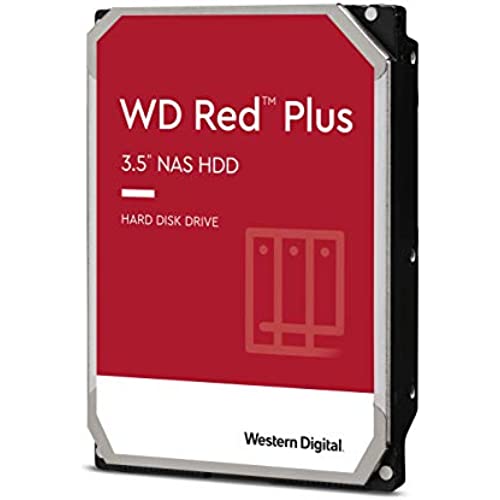
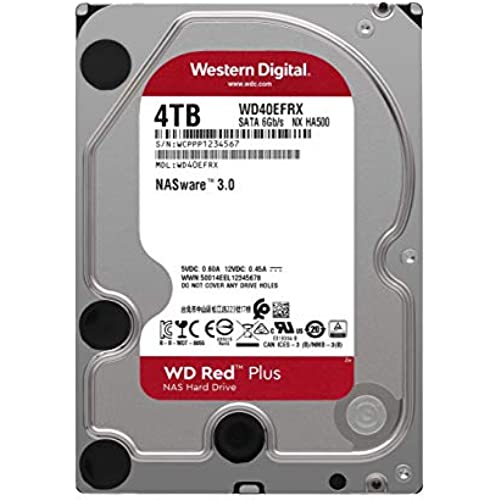
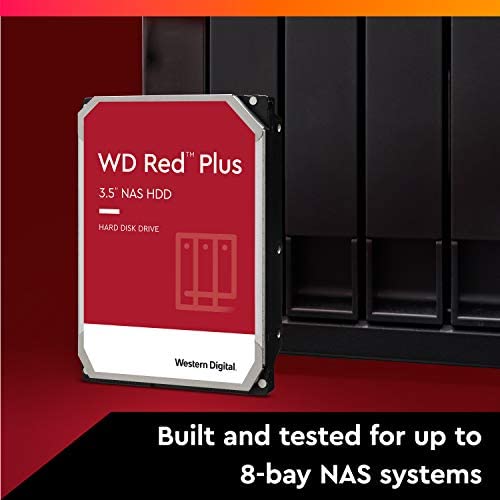
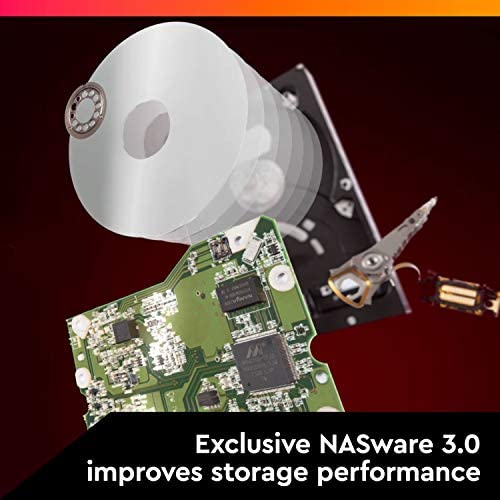

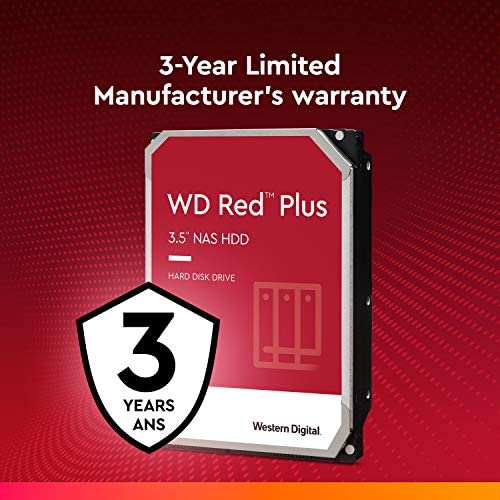
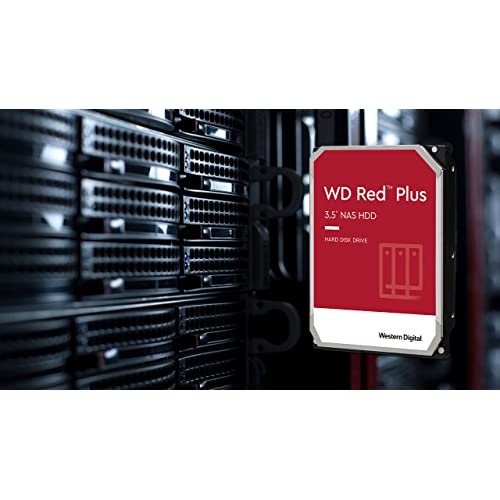







Western Digital 4TB WD Red Plus NAS Internal Hard Drive HDD - 5400 RPM, SATA 6 Gb/s, CMR, 64 MB Cache, 3.5 - WD40EFRX
-

Prof. Bryon McGlynn
> 3 dayThe reviews Ive read on this drive seem to praise how quiet it is. A review on techreport.com even stated, The WD Red 4TB is remarkably quiet; it emanates a faint hum while idling, and its seek chatter is barely audible from a few inches away.. I would agree that they are quiet while idling, but I have to say that as far as the seek chatter goes, this is not what I have experienced. I purchased 2 4TB drives from Amazon to put in my QNAP TS-251+ NAS. During certain times like booting up, launching certain apps, and copying file, I can hear the seek chatter from 10-15 feet away. In comparison, I have a 3TB WD My Passport drive that I would definitely say is quiet. I cant hear any noticable seek chatter from that even when Im right next to it. To put some proof behind what I was hearing, I put a decibel meter about 6 away from the NAS. The increase between when the drive was just iding and when it was seeking was on average about 5 dB with a peak around 7-8 dB. For those not familiar with the decibel scale, an increase of 10 dB means it is twice as loud. I decided to exchange the drives for 2 others, and unfortunately those sound just like the first 2 that I received. All 4 of the drives were manufactured in Oct 2015. Now Im not saying that its really loud, just that it is louder than I was led to believe it would be, especially since the 3TB WD Passport drive I have is not like this at all. So there are only 2 things I can conclude from this: 1. This seek chatter noise is normal for these drives and my expectations were just too high. (And maybe the NAS enclosure is amplifying the sound a bit) 2. I have bad luck and I have stumbled across a noisy batch of drives
-

B.E.N.T.
> 3 dayI purchased two of the 3TB drives and one of the 2TB drives. When I went into WDIDLE3 the setting for all three drives were set to 300 seconds (5 minutes). Since I was in there I simply disabled it. These drives are working flawlessly thus far as I have the two 3TB drives in a media center running Media Browser 3, PlayOn, and a few other apps. The 2TB drive is hooked up to a Dish Network Hopper as a secondary storage. I have not experienced any issues so far with these drive. I will update as time goes on with more info. *Update 3/27/15: Some drive information obtained from HD Guardian: Drive 01 Serial Number: WD-WCC4N7E***** Firmware: 82.00A82 User Capacity: 3,000,592,982,016 bytes Product Name Status Exp Date (MM/DD/YYYY) 3 TB WD Red Hard Drive In Limited Warranty 1/6/2018 Overall Health: Temperature: 34*C High: 36*C Low: 34*C Last Test: Completed without error. No bad sector detected. No ATA error detected. SMART Attributes Data Structure revision number: 16 Vendor Specific SMART Attributes with Thresholds: ID# ATTRIBUTE_NAME FLAG VALUE WORST THRESH TYPE UPDATED WHEN_FAILED RAW_VALUE 1 Raw_Read_Error_Rate 0x002f 200 200 051 Pre-fail Always - 0 3 Spin_Up_Time 0x0027 185 182 021 Pre-fail Always - 5733 4 Start_Stop_Count 0x0032 100 100 000 Old_age Always - 42 5 Reallocated_Sector_Ct 0x0033 200 200 140 Pre-fail Always - 0 7 Seek_Error_Rate 0x002e 100 253 000 Old_age Always - 0 9 Power_On_Hours 0x0032 100 100 000 Old_age Always - 673 10 Spin_Retry_Count 0x0032 100 253 000 Old_age Always - 0 11 Calibration_Retry_Count 0x0032 100 253 000 Old_age Always - 0 12 Power_Cycle_Count 0x0032 100 100 000 Old_age Always - 5 192 Power-Off_Retract_Count 0x0032 200 200 000 Old_age Always - 1 193 Load_Cycle_Count 0x0032 200 200 000 Old_age Always - 40 194 Temperature_Celsius 0x0022 116 110 000 Old_age Always - 34 196 Reallocated_Event_Count 0x0032 200 200 000 Old_age Always - 0 197 Current_Pending_Sector 0x0032 200 200 000 Old_age Always - 0 198 Offline_Uncorrectable 0x0030 100 253 000 Old_age Offline - 0 199 UDMA_CRC_Error_Count 0x0032 200 200 000 Old_age Always - 0 200 Multi_Zone_Error_Rate 0x0008 100 253 000 Old_age Offline - 0 Working Time: 673 hours (28 days, 1 hours) Last Update Fri Mar 27 01:53:28 2015 CDT Drive 02 Serial Number: WD-WMC4N0F***** Firmware: 82.00A82 User Capacity: 3,000,592,982,016 bytes Product Name Status Exp Date (MM/DD/YYYY) 3 TB WD Red Hard Drive In Limited Warranty 12/11/2017 Overall Health: Temperature: 37*C High: 41*C Low: 35*C Last Test: N/A No bad sector detected. No ATA error detected. SMART Attributes Data Structure revision number: 16 Vendor Specific SMART Attributes with Thresholds: ID# ATTRIBUTE_NAME FLAG VALUE WORST THRESH TYPE UPDATED WHEN_FAILED RAW_VALUE 1 Raw_Read_Error_Rate 0x002f 200 200 051 Pre-fail Always - 0 3 Spin_Up_Time 0x0027 181 179 021 Pre-fail Always - 5950 4 Start_Stop_Count 0x0032 100 100 000 Old_age Always - 50 5 Reallocated_Sector_Ct 0x0033 200 200 140 Pre-fail Always - 0 7 Seek_Error_Rate 0x002e 200 200 000 Old_age Always - 0 9 Power_On_Hours 0x0032 100 100 000 Old_age Always - 672 10 Spin_Retry_Count 0x0032 100 253 000 Old_age Always - 0 11 Calibration_Retry_Count 0x0032 100 253 000 Old_age Always - 0 12 Power_Cycle_Count 0x0032 100 100 000 Old_age Always - 4 192 Power-Off_Retract_Count 0x0032 200 200 000 Old_age Always - 1 193 Load_Cycle_Count 0x0032 200 200 000 Old_age Always - 48 194 Temperature_Celsius 0x0022 113 109 000 Old_age Always - 37 196 Reallocated_Event_Count 0x0032 200 200 000 Old_age Always - 0 197 Current_Pending_Sector 0x0032 200 200 000 Old_age Always - 0 198 Offline_Uncorrectable 0x0030 100 253 000 Old_age Offline - 0 199 UDMA_CRC_Error_Count 0x0032 200 200 000 Old_age Always - 0 200 Multi_Zone_Error_Rate 0x0008 100 253 000 Old_age Offline - 0 Working Time: 672 hours (28 days) Last Update Fri Mar 27 01:53:28 2015 CDT ------------------------------------------- Update 5/14/2015 Some drive information obtained from HD Guardian: Drive 01 Serial Number: WD-WCC4N7E***** Firmware: 82.00A82 User Capacity: 3,000,592,982,016 bytes Product Name Status Exp Date (MM/DD/YYYY) 3 TB WD Red Hard Drive In Limited Warranty 1/6/2018 Overall Health: Temperature: 37*C High: 37*C Low: 34*C Last Test: Completed without error. No bad sector detected. No ATA error detected. SMART Attributes Data Structure revision number: 16 Vendor Specific SMART Attributes with Thresholds: ID# ATTRIBUTE_NAME FLAG VALUE WORST THRESH TYPE UPDATED WHEN_FAILED RAW_VALUE 1 Raw_Read_Error_Rate 0x002f 200 200 051 Pre-fail Always - 0 3 Spin_Up_Time 0x0027 186 182 021 Pre-fail Always - 5700 4 Start_Stop_Count 0x0032 100 100 000 Old_age Always - 193 5 Reallocated_Sector_Ct 0x0033 200 200 140 Pre-fail Always - 0 7 Seek_Error_Rate 0x002e 200 200 000 Old_age Always - 0 9 Power_On_Hours 0x0032 98 98 000 Old_age Always - 1844 10 Spin_Retry_Count 0x0032 100 253 000 Old_age Always - 0 11 Calibration_Retry_Count 0x0032 100 253 000 Old_age Always - 0 12 Power_Cycle_Count 0x0032 100 100 000 Old_age Always - 5 192 Power-Off_Retract_Count 0x0032 200 200 000 Old_age Always - 1 193 Load_Cycle_Count 0x0032 200 200 000 Old_age Always - 190 194 Temperature_Celsius 0x0022 113 108 000 Old_age Always - 37 196 Reallocated_Event_Count 0x0032 200 200 000 Old_age Always - 0 197 Current_Pending_Sector 0x0032 200 200 000 Old_age Always - 0 198 Offline_Uncorrectable 0x0030 100 253 000 Old_age Offline - 0 199 UDMA_CRC_Error_Count 0x0032 200 200 000 Old_age Always - 0 200 Multi_Zone_Error_Rate 0x0008 100 253 000 Old_age Offline - 0 Working Time: 1844 hours (2 months 16 days, 20 hours) Last Update Fri May 14 22:31:35 2015 CDT Drive 02 Serial Number: WD-WMC4N0F***** Firmware: 82.00A82 User Capacity: 3,000,592,982,016 bytes Product Name Status Exp Date (MM/DD/YYYY) 3 TB WD Red Hard Drive In Limited Warranty 12/11/2017 Overall Health: Temperature: 37*C High: 41*C Low: 35*C Last Test: N/A No bad sector detected. No ATA error detected. SMART Attributes Data Structure revision number: 16 Vendor Specific SMART Attributes with Thresholds: ID# ATTRIBUTE_NAME FLAG VALUE WORST THRESH TYPE UPDATED WHEN_FAILED RAW_VALUE 1 Raw_Read_Error_Rate 0x002f 200 200 051 Pre-fail Always - 0 3 Spin_Up_Time 0x0027 181 179 021 Pre-fail Always - 5908 4 Start_Stop_Count 0x0032 100 100 000 Old_age Always - 242 5 Reallocated_Sector_Ct 0x0033 200 200 140 Pre-fail Always - 0 7 Seek_Error_Rate 0x002e 200 200 000 Old_age Always - 0 9 Power_On_Hours 0x0032 98 98 000 Old_age Always - 1836 10 Spin_Retry_Count 0x0032 100 253 000 Old_age Always - 0 11 Calibration_Retry_Count 0x0032 100 253 000 Old_age Always - 0 12 Power_Cycle_Count 0x0032 100 100 000 Old_age Always - 5 192 Power-Off_Retract_Count 0x0032 200 200 000 Old_age Always - 1 193 Load_Cycle_Count 0x0032 200 200 000 Old_age Always - 240 194 Temperature_Celsius 0x0022 110 106 000 Old_age Always - 40 196 Reallocated_Event_Count 0x0032 200 200 000 Old_age Always - 0 197 Current_Pending_Sector 0x0032 200 200 000 Old_age Always - 0 198 Offline_Uncorrectable 0x0030 100 253 000 Old_age Offline - 0 199 UDMA_CRC_Error_Count 0x0032 200 200 000 Old_age Always - 0 200 Multi_Zone_Error_Rate 0x0008 100 253 000 Old_age Offline - 0 Working Time: 1836 hours (2 months, 16 days, 12 hours) Last Update Fri May 14 22:31:35 2015 CDT
-

Pravesh Soni
Greater than one weekWhy 4 Stars instead of 5? The fact is that every mechanical hard drive will eventually fail depends on the usage and its manufacturing process control. However I can say these are the second most reliable drives. The at first place is HGST no doubt. If you are budget conscious, these are the best. I recommend to have same series drives in your NAS to get best performance and reliability. I was in habit to have a different capacity of the drives with multiple manufacturerers and ended up with frustration and no data loss thanks to the data protection and parity of the volume. I started to build my NAS with a set of 2x2TB drives and over time I increased my storage to 10TB with the same drives. Ill stick with 2TB drives to expand my storage until WD will stop manufacture not due to the fact that these are the cheapest, it is due to the fact of the existing set of drives. Im not even expecting any drive will last long as 5 years. The first set of drives which I bought is now surpassed more than three and half year and no bad sectors yet. Although Ill be expecting the first failure of the drive within a year. At the end, I say I didnt made a bad decision.
-

Scott Pederson
> 3 dayAlways looking for extra space? Yeah, me too. I had purchased an HP-MicroNAS server online, 8GB RAM but no HDs. So I added a pair of these 4TB RED disks. When they arrived, it was probably the fastest setup Id ever done. I utilized FreeNAS 11.2 (installed from a Thumb-drive) and a 750GB disk I had sitting around. The 750g was the system drive, and FreeNAS chose these two 4TB as a simple RAID1 Volume. The entire setup took about 10 minutes. Power - the whole unit uses less than 15-20w when idle, and scales up when needed. After replicating my data to this system, the drives were still inaudible, and the fan on the HP is whisper quiet too. Performance? Not the worlds fastest (at work I deal with close to 1GByte per second) but for daily archiving and storage, these are doing nicely on my 1gb LAN. Using LZ4 compression, they are doing nicely holding all of my photos and music. Additionally, my daughter is an artist and has LOTS of movie-editing files in her directory. Well see how it goes in 6mos, 1 year, 3 years. but by that time, Ill probably be using 20TB M.2 SSDs because they are $49. ;-) Bottom line, great performance and reliability for a good price.
-

SvvyShpr
> 3 dayI purchased 2 of these for an MD MyCloud Ultra2EX NAS to substitute a Synology DS220 fitted with 2 Seagate Ironwolf drives that deleted a weeks worth of work without reason or warning. Given that I dont know if the problem was the Synology or the Ironwolf drives, I just substituted everything. I transferred all the files from the Synology/Ironwolf to the MyCloud/WD Red Plus and the response time side by side (connected to the same router and even plugged onto on the same power strip was noticeable faster with these WD Red Plus drives than the Ironwolf ones. Im sticking to WD...I have tried 4 different times to give other brands the chance to prove me wrong, but they fail every single time. This last fiasco will make me a WD devote for as long as they keep this quality ethic.
-

MetalMan462
> 3 dayI run a project studio that deals with a LOT of media. From recording bands to full HD video editing, I need a lot of reliable storage. I started out with an EX4 Western Digital NAS unit that was loaded with 4 Western Digital Red drives. 4 drives at 4TB each for a total of 16TB of storage. After a year, I upgraded the Ex4 to a PR4100 unit as it was WAY faster then the EX4. I ended up moving the 4 drives from the Ex4 to the PR4100 and continued with them for another year; and they where in the NAS unit running 24/7 without any sleep mode activated on the drives. They where awake, on, and running 24/7. I just recently purchased 4 of these WD Red drives at 8TB each for a total of 32TB. I again, run the drives 24/7 in my NAS unit without any sleep modes enabled. There is no spin up/spin down time. I can not state how solid WD Red drives are. I have been using them for almost 3 years now. Theyre reliable, solid in speed when used in the right RAID configuration inside the proper NAS environments , and they are overall quiet (unless of course you are running a format on them for a new RAID setup, then they all get hammered on at the same time and make some noise). When I upgraded to the 4 new drives with 8TB on them, I took the older 4 drives with 4TB on them, and started using them in desktop PC as basic extra storage drives. No issues with any of them. They are still running solid after 3 years of use. All the drives run 24/7. I have never had a Western Digital drive die on me unexpectedly. Most of them run 3 to 4 years and I usually only replace them because I need bigger capacity drives, not because they die or fail. I highly recommended WD drives, and these red drives are fantastic!
-

MaddsPhoto
> 3 daySo far VERY GOOD. I actually just purchased this to use as a backup drive and I had a very specific mission that this helped me complete. From I dont know, 1999-Now Ive used close to 15 drives, going back to 16gb (or so) HDDs which were big back in the 90s up to 1tb drives of today, but I had a huge problem of missing files. Photos in particular. I was using drive bays to attach the old drives to the PC and try and search them all at once but Windows search really sucks. (Yes I should have booted into Ubuntu - shame on me), but I said, you know what, enough is enough, I know WD has these 6tb drives, let me literally copy the contents of ALL of the drives Ive ever owned onto it, and do one main search. Thanks to this drive, and some other creative methods *dusts self off* I did one big search of everything on this drive and found lots of old treasures, including the fountain of youth, just kidding. In recent weeks I realized, well, not that it would have helped with Windows not recognizing/initializing certain drives, but a freeware app like UltraSearch does things that windows explorer search refuses to, I guess Windows Explorer has dark moods, was tired of me playing Iggy Azalea on it, and went on strike when I tried to search for things; UltraSearch casts no aspersions with respect to my musical interests, so it just does searches for me regardless... Lo and behold, while I couldnt copy ALL the drives I own onto it, nor did I need to with respect to trying to find files from 10+ years ago, I was able to (with the help of Ubuntu), recover data off of drives that Windows 7 no longer read, but Ubuntu did, thanks Microsoft, and recover otherwise lost data onto this 6TB RED, and other newer drives from the 2000s. Its still got about 1.5tb free so Ill be using this as a third backup drive, keeping it disconnected from the PC not even in a NAS device, so I figure it will last ALOT longer. Perhaps putting it into a safe deposit box will ensure its survival in case of another Hurricane Sandy, or an Iggy Azalea attack of some sort.
-

marc
> 3 dayDrives dont fail a lot but some due. I was the lucky one to get a drive with an IO device error. I had to wait 1 month for my replacement drive (I selected standard). To my astonishment, I received an used drive.........with IO device error (impossible to format, clean, initialize). This is when I found out that WD ALWAYS RETURNS REFURBISHED DRIVES FOR RMA. Not the ideal business model in my humble opinion, as they use the drives from other RMA returns. WD claims that the drives go through extensive testing, but so did the defective drive they send me after my RMA claim. Now I escalated the issue to WD management and insisted they send me a new drive (they offered a higher capacity refurbished model, no thx). WD mgt approved this and to my great surprise received a disk with marks on the front plate, again a used drive. The disk passed all test I could possibly run on it, but writing speeds were in KB/s range (yes I did check on different slots on my server and different computers for SATA connection issues). The likeliness that you will get an inferior product is high, logically as they use recovered RMA drives. This is such a bad business policy, trying to save a couple of $$ on dissatisfied customers. I still cant wrap my mind around it. I was not going to go through this again or gamble on a 4rth drive being perfect. Raised the issue to Amazon and they refunded the money. Customer Obsession works at Amazon for sure not WD. I honestly think the issue is that terrible service center in Calexico. They never kept my RMA statuses updated, I had to insist several times on updates, they test the drives poorly (which I think is a fair claim) and I assume poorly executed the instructions on sending a new drive and took what they had on stock for my case. Once you have to deal with them, you are in a BAD position! SHOULD YOU CLAIM A RMA TRY TO GET YOUR MONEY BACK AND NOT A REPLACEMENT DRIVE SO YOU CAN BUY A NEW DRIVE. IF THAT DOENST WORK INSIST ON A NEW DRIVE. IF THAT DOESNT WORK CONTACT AMAZON AND GET A REFUND. ------------------------ WD SUPPORT STATEMENT WD’s replacement Product under its limited warranty will be manufactured from new and serviceable USED parts. PS why 2 stars? I wanted to give a higher rating, as I also own a 30EFRX and a 60EFAX which run like a dream. The 30FRX is very reliable disk check backblaze. But 3x a faulty drive? One star would not be fair.
-

Tonebalone
Greater than one weekI bought 3 of these in October 2013 to use in a home server setting. They are configured in a RAID-5 array, and they have been running 24/7 for more than 9 years straight without a glitch. Im impressed.
-

Cory in AZ
> 3 dayI purchased several of these hard drives to populate a NAS. I have been using Western Digital drives for decades and they have always been reliable and affordable. For my project, I under-estimated my drive requirements because I completely forgot about the dishonest business practice of drive manufactures counting 1000KB = 1MB. In real life, 1024KB = 1MB. The end result is that the consumer loses space and the manufacturer gets to advertise a larger capacity than what the hard drive can actually deliver. In a 4-bay NAS using 8TB drives, basic math says 4 drives x 8TB = 32TB of storage. In reality, you only get 29TB (4x7.25), which is a significant loss of 3TB over what the manufacturer advertises! Grrr!
